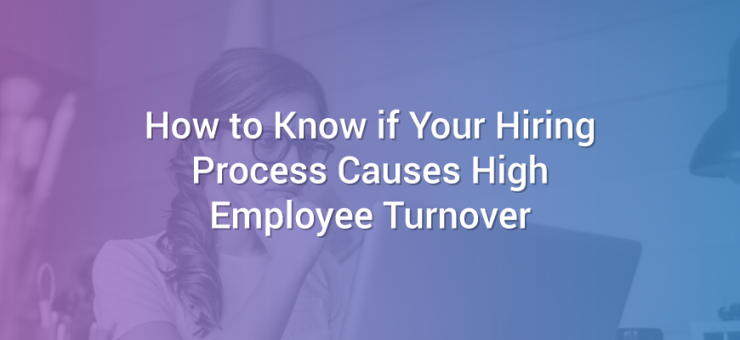Hiring top talent is costly, time-consuming, and stressful. Things become more complicated when employees choose to leave. While it may be easy to look to internal issues as the cause for new hires jumping ship, there may have been problems from the start. Oftentimes, hiring process issues lead to high turnover.
Your growing company and a competitive talent market make high employee turnover an even harder pill to swallow. In our 2018 Growth Hiring Trends report, 25% of rapidly-growing companies named high turnover as a significant obstacle when hiring. This costs your company more than just productivity and revenue. Not only is this costing your company in terms of productivity and revenue; it’s also a massive hit to company culture and morale.
To keep turnover low, growing companies must make the right hire the first time. Evaluating experience, fit, and skills is critical during the hiring process. But if you don’t notice the warning signs, a seemingly good employee could soon decide to find employment at another company.
Look for these post-hire red flags to reveal hiring process issues creating high employee turnover:
Ghosted by new hires on day one
A hiring process that drags on may cause new hires to ghost you for another offer they received in the meantime. But speeding through interviews and other critical candidate assessments could leave you with the same issue. According to our research, the optimal time to hire is between seven and 14 days from receiving the job application to sending the offer letter. If you’re looking to reduce your hiring time, you’re not alone. In our report, 56% of respondents still want to shorten their hiring process.
Find the sweet spot for a timely hiring process by determining what’s slowing things down. For instance, getting buy-in from hiring managers and team members can cause delays. An efficient solution may be video interview collaboration to collect instant feedback by sharing candidate interviews quickly with those who matter most. Dig into weak points to identify creative solutions that speed things along.
New employees struggle through onboarding
Onboarding is a critical time to assess the long-term success of new hires. Red flags pop up quickly if the hiring process was faulty. When seeking to fill open roles quickly, it can be easy to dive right into work experience and focus heavily on hard skills.
Unfortunately, our research found companies focused on remedying high employee turnover were also less likely to prioritize cultural fit. Assessing for cultural fit goes beyond confirming values and personalities align. It also gives you insight into how well a candidate’s learning and communication style meshes with the team.
Don’t forget to hone in on critical soft skills to thrive at your company or on a specific team. Consider adding a job audition in the hiring process to ensure candidates can apply the skills their resume touts while also fitting in with the company dynamic.
Engagement drops off in the first few months
Disengaged employees are typically withdrawn, lack excellent communication skills, have a noticeable decline in work quality, and are likely the company naysayers. Looking back at your hiring process, you probably didn’t assess how well these individuals would fit into the company culture or address their immediate goals within their role or future.
During the hiring process, fight disengagement contributing to high employee turnover by bringing candidates in to meet with teams they would work with if hired. This helps you assess how they align with the teams’ personalities. Keep candidates engaged and encourage transparency by allowing hiring managers to discuss a candidate’s goals for the first three months, six months, and one year of employment.
Productivity and performance are lower than expected
There are few things more frustrating than seeing a lack of productivity and performance from an employee who seemed like such a great hire. However, the employee may not be a great fit in their role. They could be overqualified, under-stimulated, or the position may not be what they expected.
Look back at the very start of your hiring process. Are the details of the roles you’re putting out current, accurate, and understandable? Connect with candidates about any responsibilities they are concerned about and why. Develop a plan to challenge overqualified candidates by molding the role to fit their skills, interests, and goals.












